 |
|
 08-07-2023, 01:05 PM
08-07-2023, 01:05 PM
|
#1
|
|
Winnebago Camper
Join Date: Dec 2020
Location: Maryland
Posts: 49
|
Looking for help with 2007 Journey 39K not starting
Sigh….. I really like these forums but dislike having to use them. ☹️
2007 Winnebago Journey 39K, 350 HP CAT C7 with Allison 6 spd on Freightliner chassis.
Problem: Last trip in early May this year. If we’re not getting it out often I normally start it up and let it run for 20-30 minutes about once a month. At the same time I run the Ginny under load for about the same time.
Long story, this morning I went out to start them as usual. Turned it to ON and only had to wait a short time for the glow plug light to go off. Started cranking the engine with it turning over not quite as strong as when out on the road but certainly strong enough to get it running. Once about 6-8 seconds in it almost started. After about 10-12 seconds (in my ocd mind it seemed like 30) so I paused to let the starter cool (as if I know when it gets warm) and when I turned it back to start, nothing. I think I detected a click but not sure from where.
I tried the Auxiliary button with the same results.
Monitor read 12.6 on both house and chassis batteries.
Started generator and tried auxiliary again with no luck. Wedged the Aux button on for about 20 minutes with again no joy.
Hooked the jumper cables to the truck and ran it for about 15 minutes. Monitor then read 12.9 house and 13.3 chassis. Still no joy. No cranking. Just perhaps a faint click.
No clue on battery life. Bought in December 2020. They looked fine and pretty new then but who knows. Dealer could have cleaned them up. Plugged into my home 110 when parked in driveway.
I don’t want to jump straight to battery replacement until I know more. From reading the threads here I suspect it may be either a loose or corroded connection somewhere or perhaps a faulty starter solenoid?
Not very electrical inclined so I’m not sure how/ where to start.
Any/All assistance appreciated.
__________________
2nd Owner 2007 Winnebago Journey 39K
|

|

|
 08-07-2023, 04:14 PM
08-07-2023, 04:14 PM
|
#2
|
|
Winnebago Master
Join Date: Nov 2018
Location: Pflugerville/Austin, Tx
Posts: 7,612
|
Sounds like a fellow who knows little electronics has actually done a really good job of sorting the problem!! You've given most all the details to make some sense of what's up!
Actually I am guessing you are very close to being right on it being a bad connection. Not always good to guess but far better than swapping out batteries and THEN find it was dirt!
There are at least two solenoids on Rv whcih we may need to know about. One is used to connect the two battery groups togehter when the engine runs or we push the dash switch. I'm saying that one if fine but even when you get the two battery groups tied together, that power has to get from the batteries to a second "starter solenoid"!
What we can get is enough 12Volt power gets to the starter area and the starter solenoid to pull the solenoid and we may hear it click. Have you ever had a car/truck that when you turned the key it just set there and went, "click,click" until you let go of the key?
What should happen is the power gets to the solenoid as we turn the key and the solenoid contacts close (click?) to connect the full battery power on the big cables to the starter and make it turn/crank.
Sometimes called a "slave relay? The little wire makes the big guy do all the real work!
But if you have dirty cables between the battery and the starter, the little guy uses some power to close the contacts but not enough is left to let the big guy turn the starter! So whether it goes click once and stops or clicks a bunch depends on how much power is actually getting to the starter area!~
So the likely cure is to go from start battery to the starter and make sure power is getting past any connections that may be dirty/corroded!
Part of the problem with just testing this with a meter is that a meter may get enough power to say 12 volts at the starter but it takes very little actual power to get a reading, while turning the starter takes a whole bunch!
Kind of like using a hose with a kink in it? You can see water come out but it may not be enough to do any real work!
There were markers put on the battery cables when new, but are they still there after 15-20 years? HUMM??? I'm guessing not but will send along the info on what "might" help??
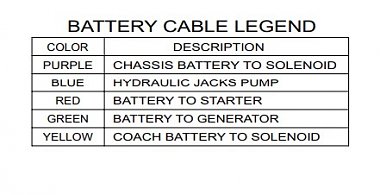
There should be tape at the ends of the cables---if still there!
Purple and yellow should be the connections from batteries to the "mode solenoid and that is where the two get connected together when running or when pushing the switch. Those would seem to be okay but worth cleaning if they look bad.
The one I "think" is the problem is the red marked one going from battery to starter. It may also have some large fuse inline between those two points and the ends of the fuse holder may need a look as some are located along the frame rail underneath where they get a lot of road grime and water!
Warning? This mega fuse can be hard to spot if it is covered in road oil, mud, etc so that it just looks like a lump!!! It can be a plastic covered lump!
Cable goes into the lump and one of the connections at either end of the lump may get corroded!
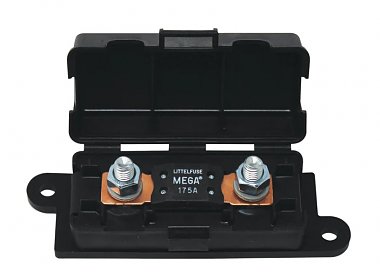
Or you mighty get lucky and just have a dirty battery cable right at the battery!
It's like Easter and you get to look under all the bushes! Good luck to you!
__________________
Richard
Why no RV year, make and floorplan on MY signature as we suggest for others?
I currently DO NOT have one! 
|

|

|
 08-07-2023, 04:54 PM
08-07-2023, 04:54 PM
|
#3
|
|
Winnebago Camper
Join Date: Dec 2020
Location: Maryland
Posts: 49
|
Morich,
Thanks for the detailed response. After I posted I went back out there and removed and sanded the neg and pos on one of the two chassis batteries. They honestly didn’t look bad at all but we all know how those stories play out. I’m low on sandpaper and I need to get one of those automotive battery post brush/cleaner when I next get out to town. Anyway she called me in to supper so I’ll work on it more tomorrow. Appreciate the attachments and insight. I’ll clean terminals and trace colored wiring to additional terminals as a good start. I’ll be back with a progress update as soon as I have something to share.
Also, it may be meaningless but I noticed after attempting to start it my key fob for the door and basement doors did not work. I manually locked up and a few hours later I tried the fob again and it worked……..twice then no more. Odd. I wonder if it rested and gained enough juice to answer the fob once or twice……
__________________
2nd Owner 2007 Winnebago Journey 39K
|

|

|
 08-07-2023, 05:26 PM
08-07-2023, 05:26 PM
|
#4
|
|
Winnebago Master
Join Date: Nov 2018
Location: Pflugerville/Austin, Tx
Posts: 7,612
|
Possible the battery did "rest" as you mention. One of the "tricks" that batteries play is the way they store energy.
More often they trick us when we are looking at how they are charged rather than discharged but it works the same except in reverse and we can see it in a parallel to water!
When we are talking battery, we are dealing with chemical reactions and it is a slow process where we put the energy in at the posts but it has to circulate all through the rest of the cells.
If we think of charging, it might look like putting black ink in a hole in a barrel. If we put a little ink in and look right away, we may see it totally black and think it is full of black ink, but if we stop putting ink in and come back in a few hours, we may not see any black at all as it has spread out to all the barrel.
When we do this with a battery , we often call it "surface charge" as the charge we put in is just at the "surface" or post where we want to look/test.
We can put 14 volts from a charger on a battery post for 15 minutes and test and it may show 13.5 volts but it is much like the black ink and when we come back 6 hours later that tiny amount of power we put in may have settled all through the battery and only test like 7 volts, etc. as we did not really give it enough time to "fill" the battery, just shot a small bit in at6 the "hole"!
Worked in reverse, when we take energy out at the post, it takes the level down but it does "refill" if we let the battery become stable again? Kind of goofy sounding but if we thought of the energy as being more slow moving like road oil or tar, we can imagine it leaving a bit of hole when we dip out some but then it seems to level out and seem closer to full again?
So saying the battery may look better after "resting" does make sense to me! We just can't see the electrons very well and it get super confusing!
Maybe we should talk about it like a checking account? We know it get refilled (we hope?) from the savings account but if we take it out too fast we run out!!! Sometimes to figure if we are really broke yet, we have to wait for it to settle down???
__________________
Richard
Why no RV year, make and floorplan on MY signature as we suggest for others?
I currently DO NOT have one! 
|

|

|
 08-07-2023, 05:52 PM
08-07-2023, 05:52 PM
|
#5
|
|
Winnebago Master
Join Date: Nov 2018
Location: Pflugerville/Austin, Tx
Posts: 7,612
|
They don't give us much help on the chassis side of things but I did find a mega fuse on the coach wiring and maybe the chassis might be near the same place on the other shelf?/
Several options on the battery number for different Rv ( 2 or 3?) but mega fuse location looks the same for both of the coach battery setups?
Sheet 2,3, or 4 of this drawing?
https://www.winnebago.com/Files/File...ire_159642.pdf
Click this snip to get better view!
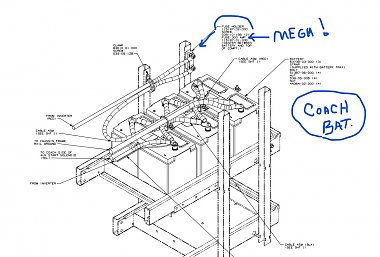
__________________
Richard
Why no RV year, make and floorplan on MY signature as we suggest for others?
I currently DO NOT have one! 
|

|

|
 08-08-2023, 11:24 AM
08-08-2023, 11:24 AM
|
#6
|
|
Winnebago Camper
Join Date: Dec 2020
Location: Maryland
Posts: 49
|
Progress Update: I bought a new battery terminal wire brush cleaning tool and proceeded to remove and clean all the terminals on both coach and chassis batteries. I didn’t see anything jump out at me in the way of a problem. A couple were slightly corroded but nothing major. I did initiate a few sparks a couple times. Not sure yet if it blew any fuses or breakers but I doubt it. Inside panel reads coach 12.9 and chassis 12.6. Tried to start it again both without and with the Aux switch. No luck.
I did see (and clean) the 300 amp fuse you noted on the coach drawer. I can see no indication if it’s blown or not. I wonder how one might know? No such fuse in the chassis drawer. I recall the batteries looked pretty good when we bought it in December 2020. The coach batteries must be pretty new as I saw a 12/20 sticker on them. I saw a couple pieces of colored tape, a red one and a yellow one so far. The small click I think I hear both when turning the ignition to start and when pushing the Aux button seems to be coming from somewhere up front and beneath the dash?
BTW, thanks so much for the diagrams and quick snip picture. I suspect we’ll get this figured out eventually but likely not without some pain.
Ok, back to it. Now I plan to see if I can squeeze under there and trace the red cable from battery to starter and clean that connection. I’ll keep my eyes open for the mega fuse on the frame rail. Still no idea how to tell if it’s bad.
Thanks for the help and support. More to follow when I know it.
__________________
2nd Owner 2007 Winnebago Journey 39K
|

|

|
 08-08-2023, 12:40 PM
08-08-2023, 12:40 PM
|
#7
|
|
Winnebago Camper
Join Date: Dec 2020
Location: Maryland
Posts: 49
|
Wow! What a rats nest of major cables in a very tight confined area! I think I see what looks like the starter with a solenoid mounted on the side of the engine. Good luck getting to those connections. I think I’ll need to see if I can crawl under there and try to sit up so I can get a better look around. I was hoping this task would be a little easier but that’s not going to be the case. How on earth do the technicians get under there and work? They must have a heavy duty lift or dry well to drive over. Neither of which I have. When I follow the large red cable from the chassis battery I see it going into the frame rail then up and on top of some kind of large metal plate near and above the transmission.
Bottom line, it’s going to be difficult to trace these major cables and I’m getting a little discouraged……..
__________________
2nd Owner 2007 Winnebago Journey 39K
|

|

|
 08-08-2023, 03:32 PM
08-08-2023, 03:32 PM
|
#8
|
|
Winnebago Master
Join Date: Nov 2018
Location: Pflugerville/Austin, Tx
Posts: 7,612
|
Okay, with that info, I still lean toward it being a problem not involving the coach and that Mega fuse but just more of the simple (but hard to trace!) bad connection on the chassis cable from the battery to the starter.
A note on the reason for the mega fuses may help. They are not like most fuses and something that may blow easily.
They are so big that it takes a really BIG problem for them to blow. Something like if you have a wreck and the cable gets mashed into the frame. They want it to shut power off before thing catch on fire but at 300 or so maps, any normal use is not likely to blow it! Blowing a 300 amp fuse is kind of close to having a lightening strike, so you've likely not blown it if still standing up!!
The second reason for not thinking it is the real problem is that it "should" not be needed to start the engine as the chassis battery is what normally does it alone.
One could verify that it is a dirty cable by putting a jumper cable from a car to the chassis battery and then try to start the RV.
The starting of the RV is just pretty much like doing a jump start on any car/truck but then there are other parts added to the normal stuff to let us do things for the RV, like charge the coach battery as we drive. But those added things should not be involved until we get the RV engine started.
I want to let you know that the idea of a mega fuse in the chassis cable is NOT something they show on the limited info we get on that truck parts group. Only an idea that there may be one but we get so little info on the chassis due to Winnebago thinking.
They buy the stripped chassis and add their parts on top with the idea that they need to know very little about the chassis and tell us little about how to fix that side of things!
__________________
Richard
Why no RV year, make and floorplan on MY signature as we suggest for others?
I currently DO NOT have one! 
|

|

|
 08-08-2023, 04:11 PM
08-08-2023, 04:11 PM
|
#9
|
|
Winnebago Master
Join Date: Nov 2018
Location: Pflugerville/Austin, Tx
Posts: 7,612
|
I may have found the solenoid that operates when we turn the igntion to hot or push the boost csh switch and may be part of what you hear?
This drawing on page 114?
https://www.winnebago.com/Files/File...07/7wkp39k.pdf
I think there is a group of breakers and relays, maybe outside under a cover next to the driver?
Know where these breakers and relays are located?
This is not the solenoid that we need to make the engine crank but it may be one to know about as they are a big part of the RV battery system and do give trouble at times.
The detail of the breakers and relays. Click these snips or go direct for better view!
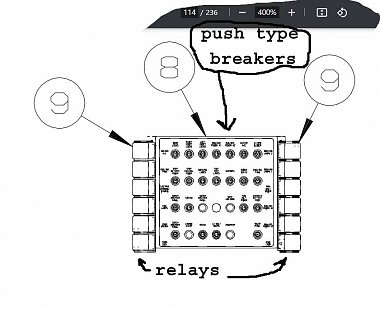
And then I think this may be the solenoid you hear click or thump when you push the boost switch?
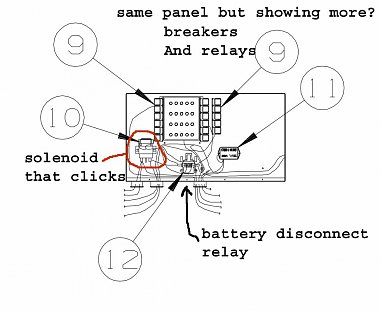
__________________
Richard
Why no RV year, make and floorplan on MY signature as we suggest for others?
I currently DO NOT have one! 
|

|

|
 08-08-2023, 04:16 PM
08-08-2023, 04:16 PM
|
#10
|
|
Winnebago Camper
Join Date: Dec 2020
Location: Maryland
Posts: 49
|
Thanks Morich. To be clear I don’t think it’s a blown mega fuse either. I tend to agree that it sounds like a poor connection on the way to the starter. I’m just not sure I’ll be able to trace those huge cables by lying on ground with my flashlight. I have to work tomorrow but on Thursday I’ll give it another try and see if I can squeeze in there and perhaps sit up a little so I can see where the starter connections are. On my trip under there today it looked like the red power cable from the chassis battery is running up over a plate that looks like it’s on the top of the tranny. I don’t think I’ll be able to see it well enough there to trace it but I’ll give it a try. I’ll bring a flashlight and mirror along to see if that helps me see better. I think I can also see a cable going to the starter and solenoid but I’ll have to get another look to be certain.
I don’t think it’s wise to work under there on the motor home jacks, but I think I could get a little more room by putting the rear jacks down to lift the rear some. Insight?
__________________
2nd Owner 2007 Winnebago Journey 39K
|

|

|
 08-08-2023, 04:32 PM
08-08-2023, 04:32 PM
|
#11
|
|
Winnebago Camper
Join Date: Dec 2020
Location: Maryland
Posts: 49
|
I think that panel is under the front hood. Thanks for digging up the documents. I’ll look there first on Thursday when I get back to it. It would be nice if I can find one tripped.
Do we know how many volts it needs to turn the starter over? I’d think the 12+ I’m seeing should be enough? I can try to jump it with the truck again?
Anyway, ok thanks.
__________________
2nd Owner 2007 Winnebago Journey 39K
|

|

|
 08-08-2023, 07:15 PM
08-08-2023, 07:15 PM
|
#12
|
|
Winnebago Master
Join Date: Nov 2018
Location: Pflugerville/Austin, Tx
Posts: 7,612
|
I've started things with less than 12 but then this is also likley to be a bigger engine, so the idea of connecting a cable from a car/truck and going direct tot he connection on the battery would be one way to KNOW it was getting plenty of power to the starter!
But that also means you have to be able to get to that starter without breaking all the joints in your arm!
On when and what you get around to doing, don't worry about me rushing you. It's likely about too hot to work anyway??
At least that makes a good excuse for me to hide in the house around here!!
__________________
Richard
Why no RV year, make and floorplan on MY signature as we suggest for others?
I currently DO NOT have one! 
|

|

|
 08-10-2023, 08:27 AM
08-10-2023, 08:27 AM
|
#13
|
|
Winnebago Camper
Join Date: Dec 2020
Location: Maryland
Posts: 49
|
Youíre not rushing me. In fact I need to get it going as we have reservations in FL in early fall. I found the panel under the dash in front above the generator. I also found another panel with automotive type fuses. Visual inspection does not indicate anything out of the ordinary but I am not familiar with checking relays and solenoids, only the automotive see thru fuses. Iíd like to attach a couple pictures of what Iím seeing but I donít see that ability here. Perhaps I need some instruction.
__________________
2nd Owner 2007 Winnebago Journey 39K
|

|

|
 08-10-2023, 10:15 AM
08-10-2023, 10:15 AM
|
#14
|
|
Winnebago Master
Join Date: Nov 2018
Location: Pflugerville/Austin, Tx
Posts: 7,612
|
I'm not seeing much to actually fix what you have currently but maybe we can swap some thinking and it may help make a few points clear.
One is the way Rv builders buy stripped chassis that have most of the truck functions in place and that often means they have different breaker/fuse boxes in different places for the things we normally expect on trucks.
That is what you have in the second picture and it has labels for what those breakers and relays may do. But it is the part which Winnebago considers a problem for other people to fix as they did not build it! We get nearly NO INFO on that part but have to search it out from chassis builders! YUCK!
But then when we look at the first picture, it matches the the drawing info I posted up in post 9! That puts it in the area Winnebago built and they give us some good info on it!
They give us 12 Volt installation drawings here:
https://www.winnebago.com/Files/File...ire_155923.pdf
This gives us a drawing of the physical layout for us to locate things.
One of the big things I see on your first picture is that there are two 55 amp breakers that are labeled as feed to other breaker panels! That's a clue that there are likely two other panels on the RV that serve the RV items like fans, lights, etc. for the inside.
To locate those other panels we may know where they are or we need to look on drawings to spot them??
While looking at this pic, I see relays for different functions as marked /labeled with blue lines. And down below and hidden almost is the solenoid which connects the two battery groups together! You may hear it click when pushing the boost switch? Then there is a big red battery cable connecting the solenoid to the coach battery disconnect relay (down out of sight?) You have a control switch somewhere that makes this relay open/close to cut off most of the coach battery drains when stored!
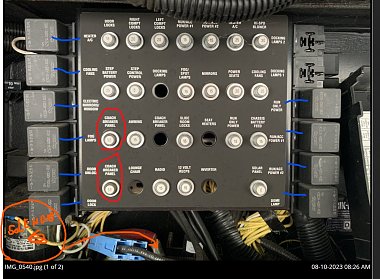
On sheet 2 of the install drawings, I spot this:
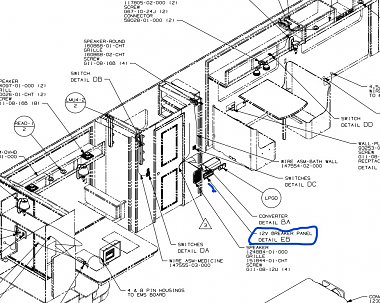
This is likely one of the panels that the 55 amp above feeds and it then breaks it down to smaller circuits. That lets us find it and then we need to go to drawings for what each breaker and each wire feeds.
This gets us the wiring schematic which lets us look at what each wire does---after we use the install drawings to find the panel!
https://www.winnebago.com/Files/File...ire_158344.pdf
So when we find the location and it shows detail EB, we look on the wiring diagram for that detail EB !
On that drawing it shows us the panel from the front to let us see the labels for things like the frig, then if we mentally turn that panel around we get the wire and the circuit ID. It takes a mental trick as the frig is third from left on front but becomes third from right when turned around to look at the back!
But the big thing it gives us is the wire and circuit ID for the frig? This frig circuit is ET and Winnebago labels the small wires.
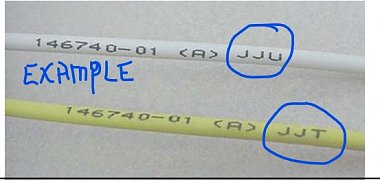
We can find the ID on wires or on drawings and then "decode" that ID here:
https://www.winnebago.com/Files/File...ical_guide.pdf
So we do get lots of detail but it takes lots of looking to sort it out. But if we combine all the small points, we can sort out that ET is a wire that goes from a 6 amp breaker to feed the frig! If we have a plug we found and it has a wire labeled ET, we can know what it does!
But we don't always have to go the hard trek of searching all the drawings if we only need simple stuff. If we have a light and want to know where we should find battery or which wire should have ground, we can look on the wire for the label and then decode it from the chart!
If we know there should be 12 volts on a lamp wire and it isn't there, we know we need to go looking for that battery supply!
Just like a road map? If we are in St.Louis and want to go to Chicago, we need to know which road to follow! 
__________________
Richard
Why no RV year, make and floorplan on MY signature as we suggest for others?
I currently DO NOT have one! 
|

|

|
 08-10-2023, 10:44 AM
08-10-2023, 10:44 AM
|
#15
|
|
Winnebago Master
Join Date: Nov 2018
Location: Pflugerville/Austin, Tx
Posts: 7,612
|
On the relay question, think of them as a set of contacts that are controlled electrically, rather than us pushing a wall switch of some type.
We push a switch and that switch may make power run through a coil that makes the relay move to close contacts.
A simple wall switch does the same as a relay or solenoid EXCEPT they use power instead of our hand?
I stole this drawing as example but this is a simple one and they come in all kinds of types with lots more contacts to do more things.
some come with diagrams printed on the side tell us what each connection does.
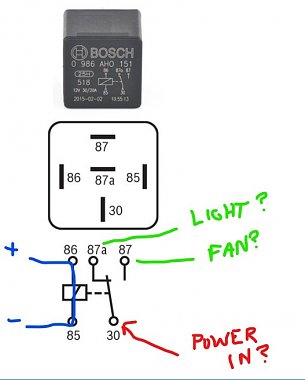
Putting battery and ground on pins 85 and 86 will make the contact they label
30 move to connect to either 87 or 87A.
If we connect 12volts to 30, it will power whatever we connect to 87A and switch to power 87 if we change the power we are putting on 85 and 86.
Exactly how and what it controls is different on about every circuit, so we have to know more about how they wired them.
The idea of testing them is to make sure the wire coil from 85 is good to 86 as that is the electro magnet that moves things. With a meter we can test for continuity from 85 to 86, but a poor man's test is to connect positvie and negative of a battery to the connections and listen/feel it move! If it's moving we say the coil is good!
But that doesn't mean those contacts inside are good and not burned or corroded! With a meter we can check that there is continuity from 30 to 87, put the battery power on 85/86 so that it clicks and then we expect to see no continuity on 30 to 87 but switches to 87A .
See how it is just a switch, turning the power on/off but doing it by the power we put on/off the coil?
On an RV that has a bunch of them like you have, one of the easy ways to test is too find another relay exactly like the suspect and swap them to see if it cures the problem! 
We do have a nasty habit of confusing things as we call them relays, solenoids, or contactors in different places we use them to do much the same thing!
__________________
Richard
Why no RV year, make and floorplan on MY signature as we suggest for others?
I currently DO NOT have one! 
|

|

|
 08-10-2023, 12:21 PM
08-10-2023, 12:21 PM
|
#16
|
|
Winnebago Camper
Join Date: Dec 2020
Location: Maryland
Posts: 49
|
You are way way way smarter than I am. Thanks for all the diagrams and words but I don’t think I’m smart enough to figure it out on my own. If you still have patience with me, we might be able to take baby steps to get there if you don’t mind babysitting me for a bit. I do know of and have checked two other breaker panels. One beneath the fridge (I think it’s the last panel picture you posted) with breakers for inside stuff. Another is at the foot of the bed. It has heavier breakers such that I find in my house.
My neighbor has a MH and is recommending we try to start it with his 50amp jump charger. He’s had the same issue and after charging for 20-30 minutes his turned over and started. He read 12.7 at the battery and it dropped to 11.4 when I turned the key to crank. Is that enough research to think power is getting out of the battery?
Chime in please with your opinion.
Started raining hard here so we packed up for now.
I’m hoping to find and correct the issue on my own (hopefully with your help and advice) but I’m seriously considering trying to locate a mobile Freightliner mechanic or technician to find the problem. Also considering the JustAsk website where they say 24/7 phone and email support for $39/mo cancel anytime.
Have you heard of this service?
I’m probably already getting more from you than I would from them?
__________________
2nd Owner 2007 Winnebago Journey 39K
|

|

|
 08-10-2023, 04:15 PM
08-10-2023, 04:15 PM
|
#17
|
|
Winnebago Master
Join Date: Nov 2018
Location: Pflugerville/Austin, Tx
Posts: 7,612
|
I'm a retired guy and the time is not a factor for much of the time. We have a situation where we can no longer travel and use an RV.
I don't want to go back to work but I also don't want to just lay around and mold so one way to keep the brain moving is to try to lend a hand/ thought on problems like you have.
So no problem with me doing whatever seems to help!
Like a BB in a bucket, I roll in whatever direction feels right!
Not that I'm smarter, just that on electrical stuff, I've been there lots of times and looking at different drawings is one thing I've done a lot!
The idea of using some other form of getting more power to the starter is good but with some mention on care. If it is just a dirty connection, adding another battery suplly is possible to make it start as more voltage to the starter is what we need.
But the downside of that is if we get it started with using more power, we may still find that it won't start when you don't have that extra power!
So you might get it started and drive 100 miles down the road and find it won't start again.
All these other parts that I've mentioned are not likely to be the realy important thing keeping it from starting but just details that may come around on other times and other problems.
I should stop throwing in so much confusion!
The main points, are the battery that has to have enough power. Adding another battery or charger will possibly make it work if it was a weak battery.
A second point is that power has to get from the battery to the starter solenoid. That solenoid might be called a switch that we operate with a switch instead of our hand. When we turn the ignition key, the solenoid should close contacts that make the power connect to the starter and make it turn. That solenoid is likely to be on the side of the starter, down bolted to the engine. I think you mentioned seeing the solenoid but it's often in a hard spot to reach!
If you put more power on at the battyery and it makes the engine start, that tells us we are not getting enough power to the starter normally, but it doesn't tell us if it is because the battery is weak, the cables are dirty or if the starter solenoid is not connecting as well as it should.
But if it won't start with his charger at the battery, it may start with the charger connected on this post right on the starter!
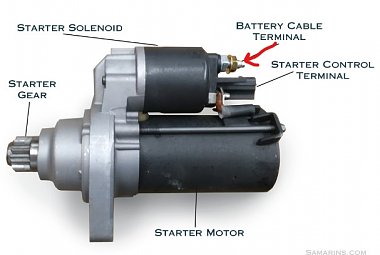
Starters come in lots of different shapes and sizes, so this may not look exactly like what you have but there should be a battery cable connected to one that looks kind of like this??
If you find it won't start with the charger connected at the battery, you might try connecting the negative charger to part of the engine as ground and positive cable to this point on the starter! Instead of the power having to get through the RV cables to the starter, you will be putting the power right on the starter and it should crank--- if the starter and solenoid are any good at all!
If it starts good then, it has to be there is something wrong along the cable from the battery to the starter!
See if that makes sense to the neighbor and maybe you can get to the starter enough to put the charger clamp on it?
__________________
Richard
Why no RV year, make and floorplan on MY signature as we suggest for others?
I currently DO NOT have one! 
|

|

|
 08-10-2023, 05:23 PM
08-10-2023, 05:23 PM
|
#18
|
|
Winnebago Camper
Join Date: Dec 2020
Location: Maryland
Posts: 49
|
Oh my, sorry to hear you don’t get to RV anymore. I too am semiretired and I like keeping busy. I have to work tomorrow and Saturday is her birthday so I’m not sure how much time I can get to work it.
I’ll get up with my friend when we can catch up. Otherwise I’ll go solo until we can get up. I have a charger as well and I recall it has a start feature? I’d just tried using the jump from the truck rather than the charger.
Ok so when I get out there I’ll see if I can squeeze back under there and get some recon on that starter. I did see the starter and felt the solenoid on top of that and you’re correct. It’ll be a bear to get to.
You do a thorough job of explaining the details. That’s a good thing.
Thanks for all the drawings, pics and documentation. Keep them coming as we need them. I can help keep you busy with this project. ��
__________________
2nd Owner 2007 Winnebago Journey 39K
|

|

|
 08-13-2023, 01:41 PM
08-13-2023, 01:41 PM
|
#19
|
|
Winnebago Camper
Join Date: Dec 2020
Location: Maryland
Posts: 49
|
Ok so I canít get to much today as itís currently 95 out there. I did manage to snap a picture of the starter solenoid. It looks like it is in need of a good cleaning regardless of whether itís the culprit or not.
My neighbor mentioned that it takes amps to start it no matter the volts. We donít know how to measure amps. He is out today but tomorrow I think weíre going to try to use his coach to jump mine. He has two new 900 amp batteries so weíre hoping itíll turn over. We think that could rule out a bad starter and lead me to think my batteries arenít cutting it. Regardless I need to try to get in there and clean those solenoid connections.
|

|

|
 08-13-2023, 03:30 PM
08-13-2023, 03:30 PM
|
#20
|
|
Winnebago Master
Join Date: Nov 2018
Location: Pflugerville/Austin, Tx
Posts: 7,612
|
YESSSIR! That looks very much like it will be the problem!
That little red wire is the control power that tells the solenoid to close/operate the contacts inside.
So a question might be if it clicks when the key is turned? They are big heavy contacts, kind of like a silver dollar on a rod that slaps up against the two bigger bolts you see where the cable from the battery comes in and when operated goes out to the starter motor!
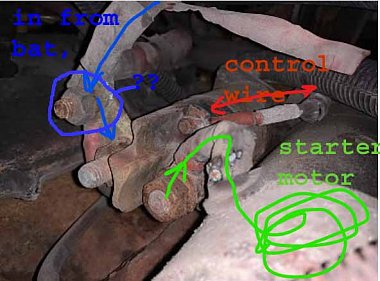
So this looks very much like the trouble.
Basic idea is that when somebody turns the key, you should be able to hear or feel this thump, if the control signal at the red wire is gettting this far.
Or if testing with a meter if you DON"T hear it move, there should be 12VDC show up on the red wire.
But if the power is getting to the solenoid, it should thump closed and the 12VDC battery that is on the cable marked in blue should be getting into the solenoid on one big contact and when the other moves to close the circuit, that power should come out of the solenoid on the green line and into the windings of the starter motor itself.
So you've got several things that "might" be good or bad as those connections do look really bad!
Is the power getting to the solenoid to make it thump or is the red wire corroded too bad?
Is the power from the battery getting across that bad looking connection into the solenoid?
There is always a chance the contacts inside the solenoid are corroded too much and when they move, they don't actually connect as they may be burned too much?
And the last stop may be where the green line is connects or is it corroded?
Worst case is that the green marked wire is "rotted" in two, so that power doesn't get to the starter winding to make it turn? That is a cable that is part of the starter build and can be fatal and need a whole new starter!
This is a place that is likely hard to get to and work but I might go with taking ALL those wires off and cleaning them up shiny, then I like a grease called, "No-OX-A" a special grease that is used on electrical connections to keep air off.
You get it in a litttle can that is way too expensive, heat it so that it is kind of like toothpaste and wipe it on all the posts and connections before you put them back together and a final last coat over the top to keep water and air from getting to the metal.
That's a fussy pro type thing that is great for doing things once and not having to worry about doing it again for a long time!
They use No-Ox on big expensive stuff and I always have a can because I don't like to do things twice! But it is just one of those things that really help head off trouble, so when it is in a vital place like this where it really is a nuisance to come back, I'm okay with taking a bit of time to avoid later trouble! 
Your choice and not needed to make it work!  https://www.amazon.com/NO-OX-ID-Spec.../dp/B00HDF9EXE
https://www.amazon.com/NO-OX-ID-Spec.../dp/B00HDF9EXE
__________________
Richard
Why no RV year, make and floorplan on MY signature as we suggest for others?
I currently DO NOT have one! 
|

|

|
 |
|
|
Currently Active Users Viewing This Thread: 1 (0 members and 1 guests)
|
|
|
 Posting Rules
Posting Rules
|
You may not post new threads
You may not post replies
You may not post attachments
You may not edit your posts
HTML code is Off
|
|
|
|
 » Recent Discussions
» Recent Discussions |
|
|
|
|
|
|
|
|
|
|
|
|
|
|
|
|
|
|
|
|
|
|
|
|
|